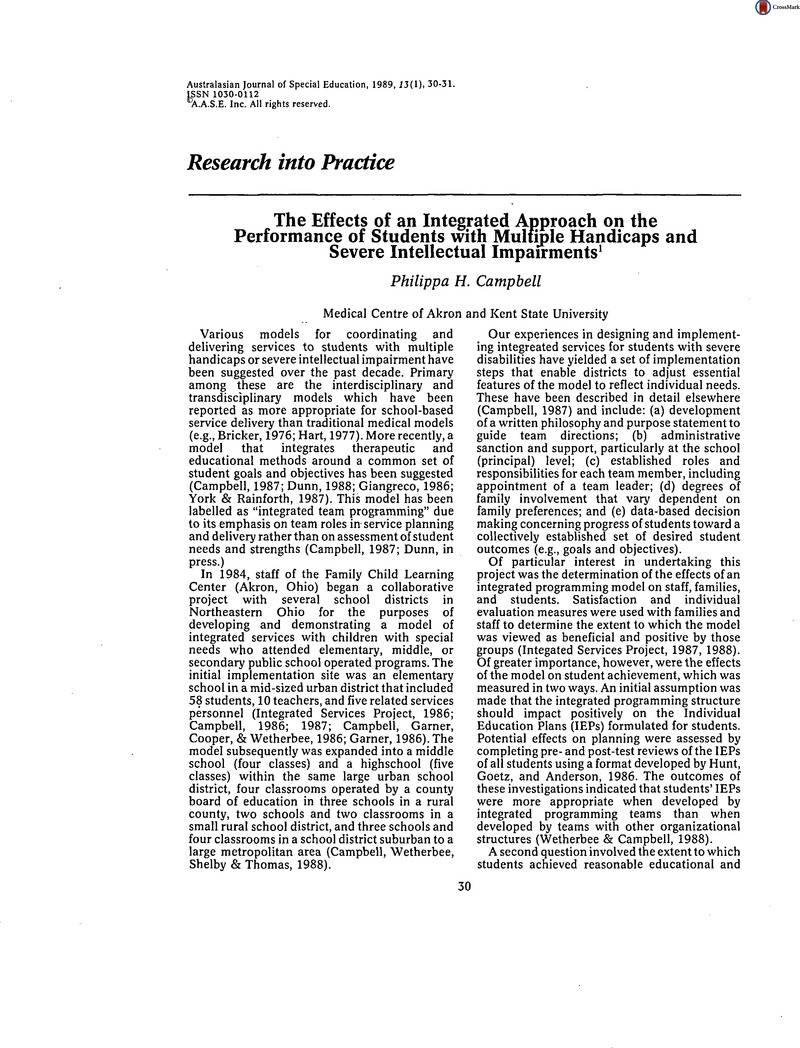No CrossRef data available.
Article contents
The Effects of an Integrated Approach on the Performance of Students with Multiple Handicaps and Severe Intellectual Impairments1
Published online by Cambridge University Press: 26 February 2016
Abstract
An abstract is not available for this content so a preview has been provided. Please use the Get access link above for information on how to access this content.

- Type
- Research into Practice
- Information
- Copyright
- Copyright © The Australian Association of Special Education 1989
Footnotes
1
Address to the National Conference of the Australian Association of Special Education, September, 1988; Sydney.
References
Bricker, D. (1976).Educational synthesizer. In Thomas, M.A. (Ed.), Hey, don’t forget about me!
Reston, VA: Council for Exceptional Children.Google Scholar
Campbell, P.H. (1986). Implementing integrated programmingteams. Akron, OH: Children’s Hospital Medical Center of Akron, Integrated Services Project. ($US5.50)Google Scholar
Campbell, P.H. (1987). Integrated programming for students with multiple handicaps. In Goetz, L., Guess, D., & Stremel-Campbell, K. (Eds.), Innovative program design for individuals with sensory impairments. Baltimore: Brookes Publishing Co.Google Scholar
Campbell, P.H., Garner, J.B., Cooper, M., & Wetherbee, R. (1986). Integrated programming: Strategies, methods and monitoring of services for students with severe and multiple handicaps. Akron, OH: Children’s Hospital Medical Center of Akron, Integrated Services Project. ($US8.50)Google Scholar
Campbell, P.H., Wetherbee, R.J., Shelby, K.D., & Thomas, T. (1988). Implementing a model of integrated programming for students with severe and multiple disabilities. Manuscript submitted for publication. (SUS3.50)Google Scholar
Campbell, P.H. & Wetherbee, R.J. (1988). Measurement of the effects of an integrated therapy model with students with severe and multiple handicaps. Children’s Hospital Medical Center of Akron. (SUS3.50)Google Scholar
Dunn, W. (1988). Models of occupational therapy service provision in the school system. American Journal of Occupational Therapy. September.Google Scholar
Dunn, W. (in press). Integrated related services. In Meyer, L., Peck, C., & Brown, L. (Eds.). Critial issues in the lives of people with severe disabilities. Baltimore: Brookes Publishing Co.Google Scholar
Garner, J.B. (1986). Integrated team planning and decision-making: Families as team members. Akron, OH: Children’s Hospital Medical Center of Akron, Integrated Services Project. ($US4.50)Google Scholar
Giangreco, M.F. (1986). Effects of integrated therapy: A pilot study. The Journal of The Association for Persons with Severe Handicaps, 11 (3), 205–215.Google Scholar
Hart, V. (1977).The use of many disciplines with the severely and profoundly handicapped. In Sontag, E., Certo, N., & Smith, C. (Eds.), Educational programming for the severely and profoundly handicapped. Reston, VA: Council for Exceptional Children.Google Scholar
Hunt, T., Goetz, L., & Anderson, J. (1986). The quality of IEP objectives associated with placement on integrated vs. segregated school sites. Jorunal of The Association for Persons with Severe Handicaps, 11 (2), 125–130.Google Scholar
The Integrated Services Project: Coordinating special education services through integrated programming. (1987). Akron, OH: Children’s Hospital Medical Center of Akron and Cuyahoga Falls, OH: Mid-Eastern Ohio Special Education Regional Resource Center. (Us1.50)Google Scholar
The Integrated Services Project - Final Report. (1986). Children’s Hospital Medical Center of Akron. (SUS3.50).Google Scholar
Wetherbee, R.J., & Campbell, P.H., (1988). The effects of integrated team planning on the instructional programs of students with orthopedic and multiple handicaps. Manuscript submitted for publication. (SUS3.50).Google Scholar
York, J., & Rainforth, B., (1987). Developing instructional adaptaitons. In Orelove, P. & Sobsey, D., Educating children with multiple disabilities. Baltimore: Brookes Publishing Co.Google Scholar




